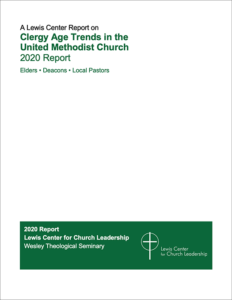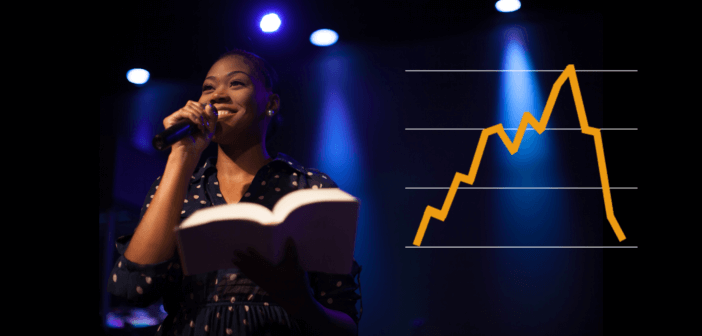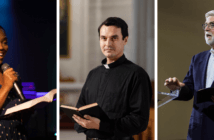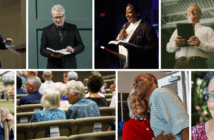Lovett H. Weems Jr. reports that the number of young elders in the United Methodist Church has dropped precipitously in the past two years. The number of elders age 35 and under has fallen nearly to the record low recorded 15 years ago, erasing a decade of progress.
This year, the number of young elders (under 35) in the United Methodist Church declined to 852, a total shockingly close to the previous low of 850 in 2005. At that time, the Lewis Center issued research documenting a 20-year decline in the presence of young clergy, and it set off alarm bells. The church responded with a range of initiatives to support and encourage younger candidates for ministry. In the decade that followed, the number of young elders increased steadily. Sadly, in 2016 these positive trends started to erode, then decline more dramatically in the past two years, to the point that today the number of young elders has dropped back to almost the same level of 15 years ago when we first named “the crisis of younger clergy.”
The crisis and the response
Fifteen years ago, the newly established Lewis Center for Church Leadership issued its first report on clergy age trends among United Methodist clergy. The research emerged from an uneasiness about a perceived absence of young clergy compared to previous eras. Few reliable statistics were easily available. Working in partnership with the General Board of Pension and Health Benefits (now Wespath Benefits), the Center opened a window on an alarming trend that illustrated the very low percentage of young clergy. The national news coverage of the initial report, well beyond denominational or even church media, showed how shocking the figures were then.
There followed a range of local initiatives from bishops, conferences, and boards of ordained ministry. The Division of Ordained Ministry hosted events and brought together those wanting to make a difference from across the denomination to share ideas. The General Conference approved legislative changes to help with both the framing and the process of entry into ordained ministry. In 2012, the General Conference approved the Young Clergy Initiative and budgeted $7 million for the quadrennium. It was reapproved for approximately the same amount in 2016.
Early progress followed by later losses
The Lewis Center’s initial Clergy Age Trend Report and subsequent reports have detailed the changing trends among elders, deacons, and local pastors. However, questions and concerns about the trends have most often centered on the dramatic changes in elders under the age of 35 (provisional or ordained).
After reviewing the statistics over the years since the first Clergy Age Trends Report in 2005, which marked the low point for the number and percentage of young elders, we can identify distinct chapters in the changing presence of young elders.
- Growth from 2006–2016. The number of young elders grew gradually but steadily through this period. While the number of male young elders decreased, a growing number of young female elders provided overall gains.
- Modest Decline from 2016–2018. The number of young elders declined modestly. There actually was a net gain of men by three with dramatic declines in women (-51).
- Major Decline from 2018–2020. Even in the period of growth, there were ups and downs between one year and the next. However, what occurred since 2018 is of a different order. Not only was there a decline of 97 young elders; the decline was closer to proportional (between men and women) than in the past: There was a net loss of 68 men and 29 women. Men represented 70 percent of the losses while representing 62 percent of the young elder pool with women representing 30 percent of the losses while representing 38 percent of young elders overall.
Interestingly, due to the overall decline in the total number of active elders in the United Methodist Church, the percentage of young elders in the pool of all active elders remains around seven percent, up from the record low of five percent in 2005. While many in the denomination are understandably discouraged about the overall decline in elders, it may be a positive sign that younger elders continue to be a significant though small cohort. It should also be noted that the percentage of young elders is lower than that of both young deacons and young local pastors.
For more details on age trends among elders, including the conferences that have larger numbers of young elders, as well as the latest figures and trends for deacons and local pastors, download Clergy Age Trends in the United Methodist Church, 1985-2020.
 The Lewis Center and Wesley Theological Seminary will hold a free Zoom panel discussion where young clergy and candidates will explore the motivations, challenges, and needs of younger people pursuing a call to ministry. The Crisis of Younger Clergy in the United Methodist Church: Young Clergy and Candidates Speak Out is Wednesday, October 21, at noon Eastern. Learn more and register now.
The Lewis Center and Wesley Theological Seminary will hold a free Zoom panel discussion where young clergy and candidates will explore the motivations, challenges, and needs of younger people pursuing a call to ministry. The Crisis of Younger Clergy in the United Methodist Church: Young Clergy and Candidates Speak Out is Wednesday, October 21, at noon Eastern. Learn more and register now.
Related Resources
- Clergy Age Trends in the United Methodist Church, 1985-2000

- 5 Reasons the Church Still Needs Young Clergy by Lovett H. Weems, Jr., and Ann A. Michel
- The Crisis of Younger Clergy by Lovett H. Weems, Jr., and Ann A. Michel







